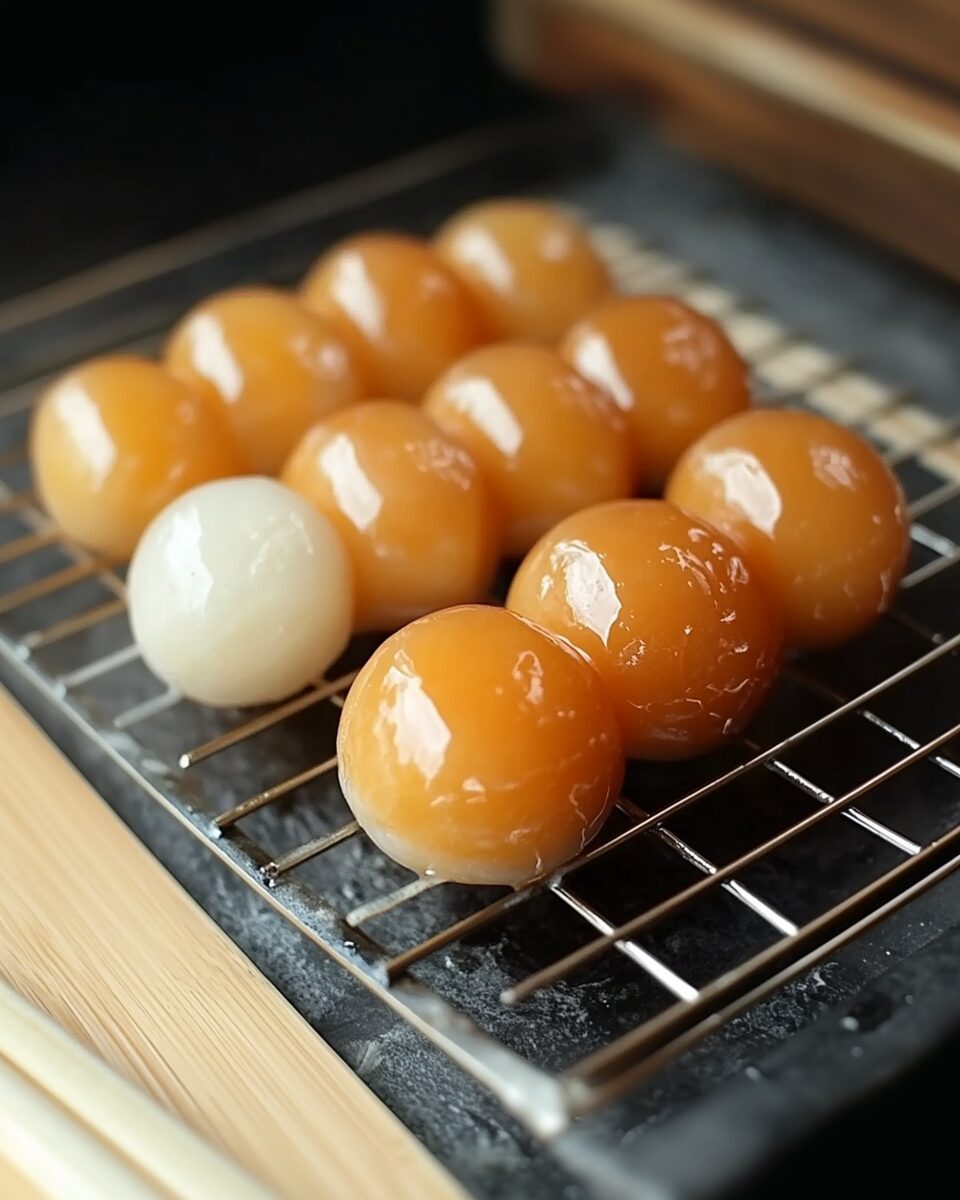Mitarashi Dango is a cherished traditional Japanese confection consisting of skewered rice dumplings glazed with a sweet and savory soy-based sauce. These chewy delights are popular street snacks in Japan, often enjoyed during festivals or as a delightful accompaniment to tea. The harmonious blend of the dumplings’ subtle sweetness with the umami-rich glaze offers a unique taste experience that has captivated palates for generations.
Full Recipe:
Ingredients
For the Dango (Rice Dumplings):
- 100 grams shiratamako (glutinous rice flour)
- 150 grams silken tofu
For the Mitarashi Glaze:
- 2 tablespoons granulated sugar
- 1 tablespoon soy sauce
- 1 tablespoon mirin (Japanese sweet rice wine)
- 1 tablespoon cornstarch or potato starch
- 80 milliliters water
Directions
-
Prepare the Dango Dough:
In a mixing bowl, combine the shiratamako and silken tofu. Knead the mixture by hand until it forms a smooth, uniform dough. -
Shape the Dumplings:
Divide the dough into equal portions and roll each into a ball approximately 2.5 cm (1 inch) in diameter. You should obtain about 15 dumplings. -
Cook the Dumplings:
Bring a pot of water to a boil. Gently add the dumplings to the boiling water. Cook until the dumplings float to the surface. Transfer to a bowl of ice water to cool and firm up. -
Skewer the Dumplings:
Once cooled, remove the dumplings and pat them dry. Thread 3 to 5 dumplings onto each bamboo skewer. -
Grill the Skewered Dumplings (Optional):
Lightly grill the skewered dumplings over an open flame or in a non-stick pan until slightly charred. This adds a touch of smokiness and enhances flavor. -
Prepare the Mitarashi Glaze:
In a small saucepan, combine the sugar, soy sauce, mirin, cornstarch, and water. Whisk until smooth. Place over medium heat and stir continuously until the sauce thickens to a glossy consistency. -
Assemble and Serve:
Arrange the skewered dumplings on a plate and brush or drizzle them with the warm glaze. Serve immediately and enjoy.
Nutritional Facts (Per skewer, assuming 5 skewers)
- Calories: 122 kcal
- Carbohydrates: 25 g
- Protein: 3 g
- Fat: 1 g
- Saturated Fat: 0.2 g
- Sodium: 233 mg
- Potassium: 77 mg
- Fiber: 1 g
- Sugar: 6 g
- Calcium: 13 mg
- Iron: 0.4 mg
Cultural and Historical Background
Mitarashi Dango finds its origins in Kyoto, Japan’s cultural heartland. The name “Mitarashi” is said to be inspired by the bubbling water at the Mitarashi Purification Fountain in the Shimogamo Shrine. Traditionally offered during religious festivals, the skewered dumplings eventually became a common treat among the general population and are now symbolic of Japanese festivals (matsuri), childhood nostalgia, and the art of wagashi (Japanese confectionery).
In the Edo period, Dango became more accessible and widespread, with various regional adaptations emerging. While many dango varieties exist—such as anko (red bean), kinako (roasted soybean flour), and yomogi (mugwort)—Mitarashi stands out due to its uniquely balanced sweet and salty sauce, which captures the essence of traditional Japanese flavor harmony.
Culinary Significance in Japan
Mitarashi Dango holds a special place in Japanese cuisine. Unlike the more elaborate wagashi often associated with formal tea ceremonies, this treat has a down-to-earth, approachable charm. It bridges the gap between everyday snacks and seasonal specialties.
In Japanese culinary tradition, the five flavors—sweet, sour, salty, bitter, and umami—are meant to be balanced, and Mitarashi Dango exemplifies this philosophy. The sauce provides a fusion of sweetness from sugar and depth from soy sauce and mirin, coating a chewy rice base that acts as the perfect neutral carrier.
It’s commonly sold at convenience stores, street food stalls, supermarkets, and traditional sweet shops, showing its widespread appeal across age groups and regions. It is also frequently featured during Japanese festivals like Hanami (cherry blossom viewing), where seasonal foods play an integral role in the cultural experience.
Symbolism and Seasonal Connection
Traditional Japanese foods often carry symbolic meanings, and Mitarashi Dango is no exception. It is traditionally served in sets of three to five dumplings on a skewer, often with a slight space between the top dumpling and the rest—a visual reflection of the human body in spiritual symbolism. This arrangement is linked to Shinto rituals where food offerings to deities include dango as a gesture of purity and gratitude.
Additionally, Mitarashi Dango is closely associated with summer festivals, particularly in Kyoto, where the dish originally gained popularity. The sweet aroma of the caramelizing sauce and the soft warmth of freshly grilled dumplings evoke feelings of nostalgia and seasonal celebration.
Texture and Taste Profile
The hallmark of Mitarashi Dango is its chewy texture, achieved through the use of glutinous rice flour, often blended with tofu for a smoother consistency. This texture contrasts beautifully with the glossy, syrupy glaze. The glaze itself is a delicate balance of sweet and salty, which plays well with the neutral-flavored dumpling, creating a bite that is both comforting and satisfying.
When grilled, the outer surface of the dumplings may char slightly, adding a layer of smokiness and a hint of crunch that deepens the flavor experience. This contrast between the soft interior and the charred exterior makes each skewer a layered delight.
Modern Interpretations and Global Influence
While Mitarashi Dango remains a staple in Japan, its popularity is gradually spreading across international borders, thanks to the global interest in Japanese culture and cuisine. Japanese cafés and dessert shops abroad now feature this delicacy on their menus, sometimes with modern twists such as:
-
Serving the dumplings with matcha or black sesame sauce
-
Infusing the glaze with yuzu or citrus zest for a fresh twist
-
Turning the dango into ice cream or parfait toppings
-
Using vegan or gluten-free versions for broader dietary accessibility
Additionally, social media has played a major role in popularizing Mitarashi Dango globally. Its charming, minimalist presentation and photogenic skewers make it a frequent subject of food photography, particularly among lovers of Japanese aesthetics.
Pairings and Serving Ideas
Traditionally, Mitarashi Dango is enjoyed alongside a cup of green tea—particularly matcha or hojicha—as the tea’s bitterness offsets the sweetness of the sauce. However, modern dining experiences may pair it with iced matcha lattes, Japanese black tea, or even as part of a larger dessert platter including mochi, anmitsu, or dorayaki.
For a more elaborate presentation, Mitarashi Dango can be served on decorative Japanese ceramic plates, garnished with edible flowers, toasted sesame seeds, or gold leaf to elevate the visual appeal without compromising authenticity.
Health and Nutrition Considerations
Mitarashi Dango is generally considered a light dessert compared to many Western-style confections. Each skewer tends to be moderate in calories, making it a sensible treat when consumed in moderation. The base ingredients—glutinous rice flour and tofu—are naturally low in fat, and the soy-based glaze, while sweet, doesn’t typically involve heavy creams or oils.
That said, the sauce does contain sugar and sodium from soy sauce, which should be kept in mind for individuals monitoring their intake. For healthier variations, the sugar can be reduced or replaced with alternatives like honey or agave syrup, and low-sodium soy sauce can be used without compromising much on flavor.
In recent years, some health-conscious Japanese chefs have also experimented with using brown rice flour, incorporating chia seeds, or adding plant-based proteins to make dango a part of balanced modern diets.
Making Mitarashi Dango at Home
Part of the charm of Mitarashi Dango lies in its simplicity. With minimal ingredients and tools required, it is a perfect entry point for those looking to explore Japanese cooking at home. The process of shaping dumplings, boiling, and skewering them can also be a relaxing and enjoyable kitchen activity—especially for families or those looking to bond over a culinary project.
The satisfaction of seeing the glaze thicken and coat each dumpling evenly is rewarding, and the final presentation is sure to impress guests despite the recipe’s humble nature. The recipe also scales easily, making it great for both solo treats and sharing at gatherings.
Why It Stands Out in Japanese Sweets
Unlike many other Japanese sweets that lean heavily on red bean paste or seasonal fruit, Mitarashi Dango relies on fundamental pantry ingredients. It stands out for its restraint, simplicity, and the duality of sweet and savory—a rare combination in desserts across global cuisines.
Its accessibility also makes it particularly appealing. Whether you’re in Tokyo or Toronto, the ingredients are easy to find or substitute, allowing for global enjoyment of this traditional dish without requiring specialty tools or niche products.
Conclusion
Mitarashi Dango is more than just a dessert—it’s a symbol of tradition, community, and culinary artistry in its most minimalist form. From its origins in Kyoto’s sacred shrines to its presence at bustling summer festivals, it captures the essence of Japanese flavor philosophy: balance, simplicity, and seasonal harmony.






